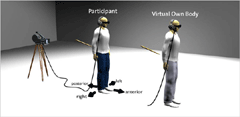
« PREVIOUS ENTRY
Math proves the baseball season should be 256 games long

This is insanely cool: A scientist hooked up some subjects to virtual-reality systems — and hacked their brains into having an out-of-body experience.
The experiments were based on a long-known trick called the “rubber hand illusion.” In this one, people hide one hand in their laps while looking at a rubber hand on the table in front of them. A researcher strokes the fake with a stick — while simultaneously stroking the real hand in precisely the same way. Pretty soon the subject begins to identify so strongly with the rubber hand that if you smash it with a hammer, the subject will freak out and “feel” the pain.
These next experiments went one step further. They involved scientists hooking up subjects with virtual-reality goggles that displayed a 3D copy of their own body, as seen from behind, in front of them. (Basically, if was as if they were standing behind themselves.) The scientists rubbed the back of the avatar with a stick while performing the same action on the real subject’s body. Voila: The subjects began to identify with the avatar so strongly that they felt they avatar was their real body — i.e. that they were floating incorporeally behind themselves.
This is, of course, precisely the sensation people report in out-of-body experiences. There’s a story by Sandra Blakeslee in today’s New York Times on the experiment, and I was surprised to learn that out-of-body experiences occur not just during near-death events and freaky meditation sessions, but sometimes during “extreme sports”. Why? Possibly because any situation that screws up your proprioception badly enough can produce a dislocation of your sense of self. As Blakeslee writes:
The research reveals that “the sense of having a body, of being in a bodily self,” is actually constructed from multiple sensory streams, said one expert on body and mind, Dr. Matthew M. Botvinick, an assistant professor of neuroscience at Princeton University.
Usually these sensory streams, which include vision, touch, balance and the sense of where one’s body is positioned in space, work together seamlessly, Dr. Botvinick said. But when the information coming from the sensory sources does not match up, the sense of being embodied as a whole comes apart.
The brain, which abhors ambiguity, then forces a decision that can, as the new experiments show, involve the sense of being in a different body.
This makes me wonder: Have any video-game players identified so strongly with their onscreen avatars that they have a slightly out-of-body experience?
Here’s one last delightful part to this story. The guy who conceived of the virtual-reality experiment? Here’s how he came up with the idea:
Last year, when Dr. Ehrsson was “a bored medical student at University College London,” he wondered, he said, “what would happen if you ‘took’ your eyes and moved them to a different part of a room.”
“Would you see yourself where your eyes were placed?” he said. “Or from where your body was placed?”
I love the way scientific breakthroughs often come from hallucinogenically odd daydreaming. Researchers let their minds drift into super weird directions and … boom! It’s like how Einstein imagined himself riding on the crest of a beam of light, tried to envision what the world would look like, and came up with the theory of relativity.
I'm Clive Thompson, the author of Smarter Than You Think: How Technology is Changing Our Minds for the Better (Penguin Press). You can order the book now at Amazon, Barnes and Noble, Powells, Indiebound, or through your local bookstore! I'm also a contributing writer for the New York Times Magazine and a columnist for Wired magazine. Email is here or ping me via the antiquated form of AOL IM (pomeranian99).

ECHO
Erik Weissengruber
Vespaboy
Terri Senft
Tom Igoe
El Rey Del Art
Morgan Noel
Maura Johnston
Cori Eckert
Heather Gold
Andrew Hearst
Chris Allbritton
Bret Dawson
Michele Tepper
Sharyn November
Gail Jaitin
Barnaby Marshall
Frankly, I'd Rather Not
The Shifted Librarian
Ryan Bigge
Nick Denton
Howard Sherman's Nuggets
Serial Deviant
Ellen McDermott
Jeff Liu
Marc Kelsey
Chris Shieh
Iron Monkey
Diversions
Rob Toole
Donut Rock City
Ross Judson
Idle Words
J-Walk Blog
The Antic Muse
Tribblescape
Little Things
Jeff Heer
Abstract Dynamics
Snark Market
Plastic Bag
Sensory Impact
Incoming Signals
MemeFirst
MemoryCard
Majikthise
Ludonauts
Boing Boing
Slashdot
Atrios
Smart Mobs
Plastic
Ludology.org
The Feature
Gizmodo
game girl
Mindjack
Techdirt Wireless News
Corante Gaming blog
Corante Social Software blog
ECHO
SciTech Daily
Arts and Letters Daily
Textually.org
BlogPulse
Robots.net
Alan Reiter's Wireless Data Weblog
Brad DeLong
Viral Marketing Blog
Gameblogs
Slashdot Games